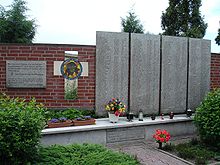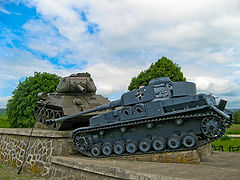- Battle of the Dukla Pass
-
Battle of the Dukla Pass Part of the Eastern Front of World War II Date 8 September – 28 October 1944 Location Dukla Pass, present-day Slovakia-Poland border Result Indecisive, Soviet halt attacks, German retreat because of the situation on other fronts Belligerents  Germany
Germany
 Hungary
Hungary Soviet Union
Soviet Union
 Czechoslovakia
CzechoslovakiaCommanders and leaders  Gotthard Heinrici
Gotthard Heinrici
 Géza Lakatos
Géza Lakatos
 Dezső László
Dezső László Ivan Konev
Ivan Konev
 Andrei Grechko
Andrei Grechko
 Kirill Moskalenko
Kirill Moskalenko
 Ludvík Svoboda
Ludvík SvobodaStrength 100,000 soldiers
2,000 artillery pieces
350 tanks120,000 - 150,000 Soviet soldiers
16,700 Czechoslovak soldiers
1 517 artillery pieces
1,724 mortars
1,000 tanksCasualties and losses 20,000[1] - 70,000 20,000[1] - 21,000 dead
80,000[1] - 123,000 total (Soviet)
6 500 CzechoslovakNaval warfare
- Baltic Sea
- Black Sea
- Arctic
1941
1942
- Battles of Rzhev
- Toropets and Kholm
- Demyansk
- Velikiye Luki
- Mars
- 2nd Kharkov
- Case Blue
- Stalingrad
1943
1944
- Dnieper and Carpathian
- Leningrad and Novgorod
- Narva
- Hube's Pocket
- Crimea
- Jassy-Kishinev
- Karelia
- Bagration
- Lvov and Sandomierz
- 2nd Jassy-Kishinev
- Baltics
- Debrecen
- Petsamo and Kirkenes
- Hungary
1945
Battle of the Dukla Pass, also known as the Dukla / Carpatho-Dukla / Rzeszów-Dukla / Dukla-Prešov Offensive was the scene of bitterly contested battle for the Dukla Pass (borderland between Poland and Slovakia) on the Eastern Front of World War II between Nazi Germany and the Soviet Union in September-October 1944. German resistance was much harder than expected. The battle which began on 8 September would not see the Soviet forces on the other side of the pass until 6 October, and German forces would stop their heavy resistance in the region only around 10 October. Five days to Prešov turned into fifty days to Svidnik alone with over 70,000 casualties on both sides. Prešov that was to be reached in six days remained beyond the Czechoslovaks' grasp for four months.[2] The battle would be counted among one of the most bloody in the entire Eastern Front and in the history of Slovakia;[3] one of the valleys in the pass near villages of Kapisova, Chyrowa, Iwla and Głojsce would become known as the Valley of Death.[1]
Contents
Background
In summer 1944, Slovaks rebelled against the Nazis and the Czechoslovak government appealed to Soviets for help. On 31 August, Soviet marshal Ivan Konev was ordered to prepare plans for an offensive to destroy Nazi forces in Slovakia. The plan was to push through the old Slovak-Polish border in the Carpathian Mountains via the Dukla Pass near Svidnik to penetrate into Slovakia proper.[4]
In the meantime, however, the Germans had fortified the region, forming the Karpatenfestung or Árpád line.
Battle
The Soviet operation plan called for the Soviet forces to cross the pass and capture the town of Prešov within five days.[5]
The operation started on 8 September. It took the Soviets three days to take Krosno (it was captured on 11 September). One of the biggest battles in the pass took place on and around Hill 534 in the northwest from the town of Dukla; the battle to capture this hill lasted from 10-20 September, and during that period the control of the hill changed more than 20 times.[5] The town of Dukla was seized on 21 September.[5] The area of the former Czechoslovakian state border—heavily fortified by the Germans—was captured on 6 October; it took almost a month for the Soviet forces to reach Slovakia.[5]
The Dukla operation did not end when the Soviets forced the pass. The combat zone shifted to Eastern Slovakia, with Soviet forces trying to outflank and push back the German forces, still strong and having many fortified positions. South of the pass and directly west of the village of Dobraslava lies an area which has come to be known as the "Valley of Death." Here Soviet and German armor clashed in a miniature reenactment of the great tank battle of Kursk.[1] Soviet and Czechoslovak forces would enter Svidnik on 28 October.[1] A major German fortified position near the pass, Hill 532 "Obšár", would be secured as late as on 25 November 1944.[5]
 The German 97th Jäger Division Memorial to the Victims of Wars, Krzanowice
The German 97th Jäger Division Memorial to the Victims of Wars, Krzanowice
 The Czechoslovak soldiers Memorial to the Victims of Wars 1944, Nowosielce Sanok County
The Czechoslovak soldiers Memorial to the Victims of Wars 1944, Nowosielce Sanok County
Aftermath
The Slovak National Uprising was mostly crushed by the time Soviet units secured Slovak territories; one of the main reasons for it was that the German resistance in the Dukla Pass was much heavier than expected. Another factor was that the Slovak insurgent forces failed to secure the other side of the pass, as planned by the Slovak and Soviet commanders during early preparations.[4]
The Soviet delay and eventual failure in providing support for the insurgents led to the accusations that it was deliberate, just as in the case of the Warsaw Uprising—that Joseph Stalin wanted to weaken the Czechoslovak forces to facilitate the eventual Soviet takeover of that country.[1]
In 1949, the Czechoslovak government erected a memorial and cemetery southeast of the Dukla border crossing, in Vysny Komarnik, Slovakia's first liberated village. It contains the graves of several hundred Russian and Czechoslovak soldiers. Several other memorials and cemeteries have also been erected in the region.[4]
Order of battle
Soviet Union
- Elements of Ukrainian 1st Front, Marshal Ivan Konev commanding
- 38th Army (Kirill Moskalenko)
- Czechoslovak 1st Army Corps / Czechoslovakian 1st Army / I československý armádní sbor / 1-й чехословацкий армейский корпус (Ludvik Svoboda) [6]
- Elements of Ukrainian 4th Front:
- Soviet 1st Guards Army (Andrei Grechko)
Germany
- Army Group Heinrici
- German 1. Panzerarmee (Gotthard Heinrici)
- Elements of Hungarian First Army attached to the 1. Panzerarmee
Notes
References
- Andrusikiewicz J., Boje o Przełęcz Dukielską (w:) "Wierchy" t. 37, Kraków 1968
- Grzywacz-Świtalski Ł., Z walk na Podkarpaciu, Warszawa 1971
- Luboński P., Operacja dukielsko-preszowska (w:) Magury’ 83, Warszawa 1983
- Michalak J., Dukla i okolice, Krosno 1996
External links
- Post-Dukla 1944 Soviet Offensive Operations in Eastern Slovakia
- Maps of operations in Carpathian Mountains including battle of the Dukla Pass: http://rkkaww2.armchairgeneral.com/maps/1944SW/1UF/CZ/s17_Carpatians_Sep_Nov44_eng.jpg, http://www.rkka.ru/maps/dukl.gif, http://rkkaww2.armchairgeneral.com/maps/1944SW/1UF/CZ/38A_Dukla_s04_Sept27_Nov8_44.gif
- Diorama painting and Google Earth view of the pass
- Commemorative medal of the Battle of Dukla Pass
- Monuments to the battle
Categories:- Conflicts in 1944
- 1944 in Czechoslovakia
- Battles and operations of the Soviet–German War
- Battles and operations of World War II involving Czechoslovakia
- Czechoslovakia–Soviet Union relations
- Battles of World War II involving Germany
Wikimedia Foundation. 2010.


